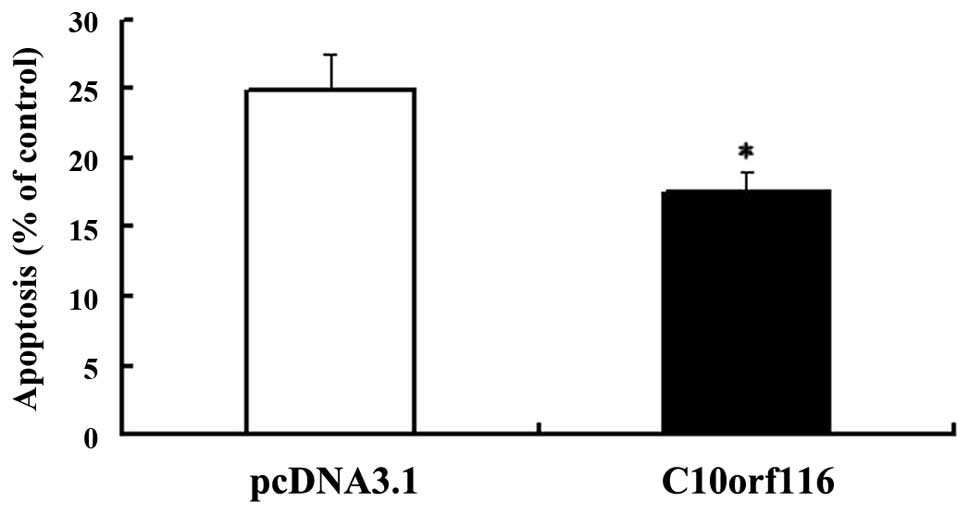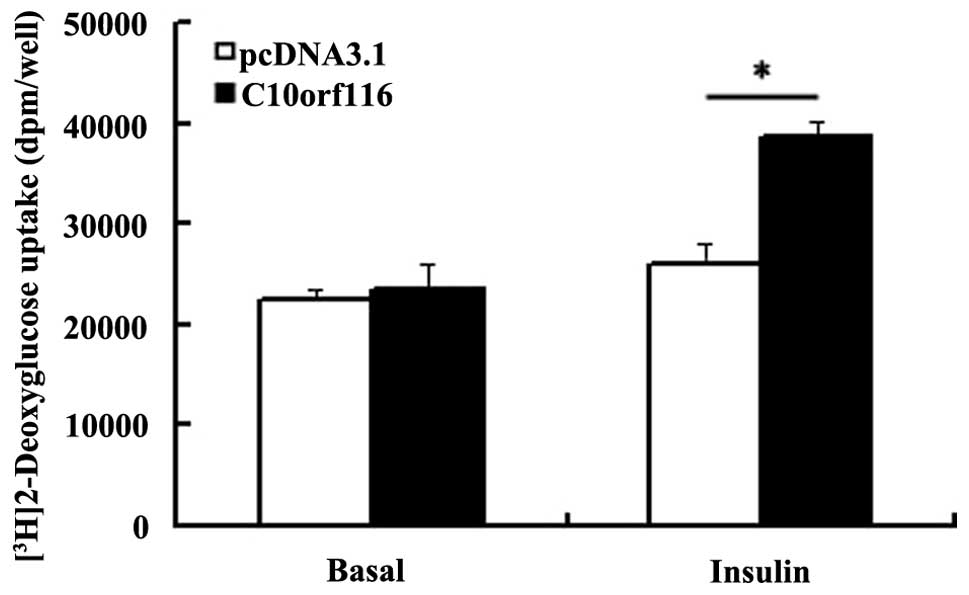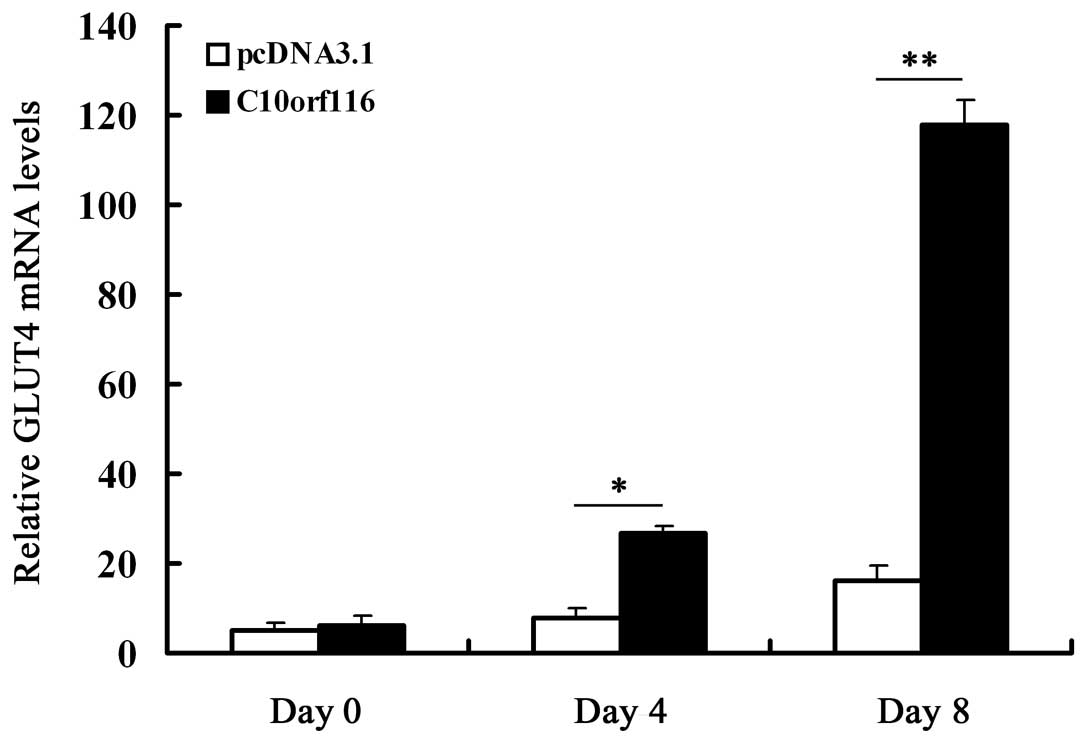Overexpression of C10orf116 promotes proliferation, inhibits apoptosis and enhances glucose transport in 3T3-L1 adipocytes
- Authors:
- Published online on: March 1, 2013 https://doi.org/10.3892/mmr.2013.1351
- Pages: 1477-1481
Abstract
Introduction
Obesity results from the interaction between genetic, environmental and psychosocial factors. Obesity poses an important public health issue in the developed world and a growing health issue in the developing world. The current worldwide epidemic of obesity, along with its implications for public health, emphasizes the importance of understanding the complex mechanisms implicated in its development. Although >600 genes, markers and chromosomal regions have been identified to be associated with or linked to human obesity phenotypes (1), the responsible genes remain unknown in >95% of severe obesity cases (2). Thus, identification of novel genes and proteins associated with the development of obesity remains an important issue.
Data from our previous study (3) demonstrated that C10orf116 is highly expressed in adipose tissue and is localized primarily within the nucleus. Overexpression studies in 3T3-L1 cells indicated that C10orf116 upregulated the transcription levels of CCAAT-enhancer-binding protein (C/EBP)α and peroxisome proliferator-activated receptor (PPAR)γ, and promoted adipogenic differentiation during the early stages of adipogenesis. However, more precise functional properties of this gene need to be clarified and require further investigation.
In the present study, we report on the effects of C10orf116 on cell proliferation and apoptosis in vitro. Our results indicate that the overexpression of C10orf116 in preadipocytes stimulates proliferation and inhibits apoptosis. Furthermore, we investigated the effects of C10orf116 on glucose uptake and demonstrated that the ectopic expression of C10orf116 significantly increases insulin-stimulated glucose uptake in adipocytes by increasing glucose transporter type 4 (GLUT4) expression levels.
Materials and methods
Cell culture and differentiation
3T3-L1 preadipocytes [American Type Culture Collection (ATCC), Manassas, VA, USA] were maintained in Dulbecco’s medified Eagle’s medium (DMEM) supplemented with 10% fetal calf serum (FCS) (Biomedia, Boussens, France), 100 U/ml penicillin and 50 μg/ml streptomycin (Invitrogen, Life technologies, Carlsbad, CA, USA) at 37°C in 5% CO2. The 3T3-L1 cells that were stably integrated into either the pcDNA3.1Myc/HisB-C10orf116 plasmid or the empty vector were established as previously described (3). To induce differentiation, 2-day post-confluent 3T3-L1 preadipocytes (day 0) were exposed to differentiation cocktail (100 μM methylisobutylxanthine, 0.25 μM dexamethasone and 1 μg/ml insulin). Two days later (day 2), cells were switched to medium containing 1 μg/ml insulin for 2 days (day 4). The cells were then switched back to DMEM containing only 10% FCS until day 8. Cultures were replenished every 2 days.
3-(4,5-Dimethylthiazol-2-yl)-2,5-diphenyltetrazolium bromide (MTT) assay
Adipocytes (2×102 cells/well) were seeded in 96-well culture plates and maintained in serum-free DMEM for 24 h until they were adherent. The cells were then cultured in DMEM supplemented with 10% FCS. Cell growth was monitored for 7 days successively using the Cell Proliferation MTT kit (Roche Diagnostics GmbH, Mannheim, Germany) according to the manufacturer’s instructions. Following this, 10 μl of MTT labeling reagent were added to each well and incubated for 4 h at 37°C. Solubilization solution (100 μl) was then added to each well and cells were incubated overnight. The absorbance values at 560 and 660 nm were recorded by an ELISA reader and the difference between these values was recorded as the optical density (OD).
Cell cycle assay
Cells were incubated at a density of 2×106 cells/750 mm2 in DMEM supplemented with 10% FCS, then washed with PBS and starved in serum-free DMEM for 24 h for synchronization. The cell cycle was initiated by replacement of the starvation medium with full medium (DMEM with 10% FCS) at various time points (0, 6, 12, 18, 24 h) following serum deprivation. Cultured cells were harvested using trypsin/EDTA and washed twice with PBS. Aliquots of 2×106 cells were centrifuged, fixed in 70% ethanol and stained with 500 μl propidium iodide (PI) solution (100 μg/ml RNase and 50 μg/ml PI in 1X PBS). Labeled cells were analyzed using a BD FACScan (BD Biosciences, Franklin Lakes, NJ, USA) and data were analyzed using CellQuest software (BD Biosciences).
Evaluation of apoptotic index
Cells were cultured in FCS-free DMEM for 24 h to induce apoptosis. Cells were then harvested using trypsin/EDTA, washed with PBS, resuspended in 1 ml of binding buffer and stained with 10 μl fluorescein isothiocyanate (FITC)-labeled Annexin V and 10 μl PI at room temperature for 5 min (BioVision, Mountain View, CA, USA). The fluorescence of FITC and PI was analyzed by flow cytometry.
Hoechst 33342 staining
Following the induction of apoptosis, cells were treated with the apoptosis Hoechst 33324 staining kit (Sigma, St. Louis, MO, USA) for 5–10 min according to the manufacturer’s instructions. The cells were incubated with phenol red-free Hanks’ balanced salt solution containing 3 μM of Hoechst 33342 and washed with PBS twice. Images were observed under a fluorescence microscope.
Caspase-3 and -8 activity
Following the induction of apoptosis, cells were collected and washed with PBS. The activity of caspase-3 and -8 was assayed using commercially available kits (Sigma) according to the manufacturer’s instructions. The measurements were based on the hydrolysis of acetyl-Asp-Glu-Val-Asp p-nitroanilide (Ac-DEVD-pNA). The reaction results in the release of the p-nitroaniline (pNA) moiety. The pNA moiety was detected spectrophotometrically at 405 nm. The concentration of pNA released from the substrate was calculated from a calibration curve prepared with pNA standards. In order to confirm the measurements, additional experiments using adequate inhibitors included in the kit were performed.
Glucose uptake
2-Deoxy-D-[3H]glucose (CIC, Beijing, China) uptake was assayed as previously described (4). The cells were cultured in 6-well plates and were serum starved in DMEM containing 0.5% FCS for 3 h prior to the experiments. The cells were then washed twice with PBS and incubated in KRP-HEPES buffer [30 mmol/l HEPES (pH 7.4), 10 mmol/l NaHCO3, 120 mmol/l NaCl, 4 mmol/l KH2PO4, 1 mmol/l MgSO4 and 1 mmol/l CaCl2] in the presence or absence of 100 nmol/l insulin for 30 min at 37°C. Labeled 2-deoxy-D-[3H] glucose was added to a final concentration of 2 μCi/ml. After 10 min at 37°C, the reaction was terminated by washing with ice-cold PBS 3 times, supplemented with 10 mmol/l D-glucose. The cells were solubilized by adding 200 μl of 1 mol/l NaOH to each well and aliquots of the cell lysate were transferred to scintillation vials for radioactivity counting; the remainder was used for the protein assay.
GLUT4 expression
Total RNA was extracted from 3T3-L1 adipocytes using TRIzol reagent (Invitrogen Life Technologies) and the extracted RNA was quantified by spectrophotometry at 260 nm. cDNA was synthesized from 1 μg of total RNA by using an AMV Reverse Transcriptase kit (Promega A3500; Promega Corp., Madison, WI, USA) according to the manufacturer’s instructions. Real-time RT-PCR was performed using the TaqMan Sequence Detection System and the DNA double-strand-specific SYBR-Green I dye (Roche Diagnostics GmbH) according to the manufacturer’s instructions. The samples were briefly incubated at 95°C for 10 min for an initial denaturation, followed by 40 PCR cycles. Each cycle consisted of incubation at 95°C for 15 sec and 60°C for 1 min. We used β-actin as the reference in a comparative CT method and obtained the relative changes in the target samples. We used the following primers for the PCR analyses: GLUT4 homologous genes in mouse forward, 5′-ATT GGA CGC TCT CTC TCC AA-3′ and reverse, 5′-GAT TCT GCT GCC CTT CTGTC-3′; and β-actin forward, 5′-ATC TGG CAC CAC ACC TTC-3′ and reverse, 5′-AGC CAG GTC CAG ACG CA-3′.
Statistical analysis
All data are expressed as the means ± SEM. Statistical analysis was performed using the paired Student’s t-test using the SPSS 10.0 statistical software package (SPSS, Inc., Chicago, IL, USA). P<0.05 was considered to indicate a statistically significant difference.
Results
Effects of C10orf116 on cell proliferation
As indicated by MTT assay (Fig. 1), the overexpression of C10orf116 in 3T3-L1 preadipocytes resulted in a significantly higher rate of proliferation compared with the cells transfected with the empty vector at each time point. C10orf116 also had an effect on the cell cycle. The percentage of 3T3-L1 cells overexpressing C10orf116 in the S phase was significantly higher compared to the control cells following the replacement of the starvation medium with full medium at 12, 18 and 24 h and following serum deprivation, as shown by flow cytometry (Fig. 2).
Effects of C10orf116 on cell apoptosis
Annexin V was shown to interact strongly and specifically with phosphatidylserine and may be used to detect the early stages of apoptosis by targeting the loss of plasma membrane asymmetry (5). To examine the effects of C10orf116 on cell apoptosis, cells were cultured in FCS-free DMEM for 24 h to induce apoptosis and the apoptotic index was analyzed. As shown in Fig. 3, C10orf116 protects 3T3-L1 preadipocytes from serum deprivation-induced apoptosis. In addition, the results of the Hoechst 33342 staining demonstrated that the 3T3-L1 cells transfected with the pcDNA.3.1 vector exhibited more significant apoptotic morphological changes, including chromatin condensation and the formation of apoptotic bodies (Fig. 4C) compared with the cells transfected with the C10orf116-pcDNA3.1 vector (Fig. 4D). However, no significant differences were observed in the control cells (Fig. 4A) and the cells overexpressing C10orf116 without the induction of apoptosis (Fig. 4B). Caspase-3 and -8 activity was also determined. The data (Fig. 5) also showed that 3T3-L1 preadipocytes transfected with the C10orf116-pcDNA3.1 vector had a lower caspase-3 and -8 activity compared with the cells transfected with the pcDNA.3.1 vector. These results indicate that C10orf116 inhibits apoptosis in preadipocytes induced by serum deprivation.
Effects of C10orf116 on basal and insulin-stimulated glucose uptake and GLUT4 expression
The transfected 3T3-L1 preadipocytes were induced to differentiate as described in Materials and methods. Glucose uptake was then assayed in the 3T3-L1 adipocytes with or without C10orf116 overexpression. As shown in Fig. 6, the insulin-stimulated glucose uptake was significantly enhanced in the adipocytes overexpressing C10orf116; however, the basal glucose uptake was similar compared with the control cells. In the adipocytes, insulin-stimulated glucose uptake is dependent on the expression, the activity or the translocation of the insulin-responsive glucose transporter GLUT4 (6–10). Therefore, we further examined the effects of C10orf116 on GLUT4 expression during the differentiation of 3T3-L1 preadipocytes. The results demonstrated that C10orf116 overexpression significantly increased GLUT4 expression on days 4 and 8 of differentiation (Fig. 7).
Discussion
Obesity is an increasing global health issue that is usually accompanied by a number of serious health impairments, including type 2 diabetes and cardiovascular disease (11). Considerable evidence suggests that obesity is caused by the interaction between multiple genes and the environment (12,13). A better understanding of the candidate genes required for the development of obesity may form the basis for novel therapies that directly target the molecular mechanisms underlying obesity. In our previous study (3), we identified C10orf116 as a novel gene that may be important in the development of obesity. Overexpression studies in 3T3-L1 cells indicated that C10orf116 upregulated the transcription levels of C/EBPα and PPARγ, and promoted adipogenic differentiation beginning from the early stage of adipogenesis. In the present study, we further investigated the association between C10orf116 and obesity.
As a metabolic and endocrine organ, adipose tissue is important in the regulation of energy balance (14). Accordingly, adipocytes are emerging as a potential therapeutic target for obesity, type 2 diabetes and cardiovascular disease (15). Adipose tissue mass reflects the number and average volume of adipocytes, in particular the balance between cell acquisition and cell loss (16–18). The proliferation of adipocyte precursors and their differentiation into mature adipocytes contribute to the development of obesity in mammals. Apoptosis is another important mechanism regulating adipose tissue mass (19–22). Therefore, we further investigated the effects of C10orf116 on 3T3-L1 preadipocyte proliferation and apoptosis by establishing a stably transfected 3T3-L1 cell line overexpressing C10orf116 and demonstrated that: i) C10orf116 causes the promotion of cell population growth in 3T3-L1 preadipocytes indicated by results of MTT assay, and cell cycle analysis by flow cytometry showed a significantly increased percentage of cells in the S phase in C10orf116-overexpressing preadipocytes; ii) cell apoptosis analysis by Annexin V-FITC, Hoechst 33342, caspase-3 and -8 activity demonstrated that C10orf116 may prevent apoptosis induced by serum deprivation. In conclusion, our data demonstrate that by increasing cell proliferation and lowering the apoptotic rate, C10orf116 may affect the size of the preadipocyte pool and influence adipose tissue homeostasis. The function and mechanism of C10orf116 in adipocytes requires further investigation.
In adipocytes, insulin plays a role in multiple stages of glucose metabolism. One of its most important effects is the ability to increase the rate of cellular glucose transport (23). In this study, we observed that C10orf116 overexpression significantly increases insulin-stimulated glucose transport in mature adipocytes and exerted no effect on basal glucose uptake. We examined GLUT4 expression to determine the mechanism by which C10orf116 increases insulin-stimulated glucose uptake. The results indicated that C10orf116 affected insulin-stimulated glucose uptake by increasing GLUT4 expression levels.
Collectively, these data further support the hypothesis that C10orf116 is important in regulating the number of preadipocytes and glucose transport in adipocytes and aids in the understanding of the complex mechanisms responsible for obesity. However, in vivo research is required to verify the physiological functions of this gene. Future studies addressing the biochemical and functional properties of C10orf116 may provide further insight into its role in obesity.
Acknowledgements
This study was supported by grants from the National Key Basic Research Program of China (2013CB530604), the National Natural Science Foundation of China (no. 81000349) and the Science and Technology Development Fund of Nanjing Medical University (09njmum052).
References
|
Pérusse L, Rankinen T, Zuberi A, et al: The human obesity gene map: the 2004 update. Obes Res. 13:381–490. 2005. | |
|
Flier JS: Obesity wars: molecular progress confronts an expanding epidemic. Cell. 116:337–350. 2004. View Article : Google Scholar : PubMed/NCBI | |
|
Ni Y, Ji C, Wang B, Qiu J, Wang J and Guo X: A Novel pro-adipogenesis factor abundant in adipose tissues and over-expressed in obesity acts upstream of PPARγ and C/EBPα. J Bioenerg Biomembr. Dec 13–2012.(Epub ahead of print). | |
|
Ceddia RB, Somwar R, Maida A, Fang X, Bikopoulos G and Sweeney G: Globular adiponectin increases GLUT4 translocation and glucose uptake but reduces glycogen synthesis in rat skeletal muscle cells. Diabetologia. 48:132–139. 2005. View Article : Google Scholar : PubMed/NCBI | |
|
Vermes I, Haanen C, Steffens-Nakken H and Reutelingsperger C: A novel assay for apoptosis. Flow cytometric detection of phosphatidylserine expression on early apoptotic cells using fluorescein labelled Annexin V. J Immunol Methods. 184:39–51. 1995. View Article : Google Scholar | |
|
Bryant NJ, Govers R and James DE: Regulated transport of the glucose transporter GLUT4. Nat Rev Mol Cell Biol. 3:267–277. 2002. View Article : Google Scholar : PubMed/NCBI | |
|
Kanzaki M: Insulin receptor signals regulating GLUT4 translocation and actin dynamics. Endocr J. 53:267–293. 2006. View Article : Google Scholar : PubMed/NCBI | |
|
Tozzo E, Gnudi L and Kahn BB: Amelioration of insulin resistance in streptozotocin diabetic mice by transgenic overexpression of GLUT4 driven by an adipose-specific promoter. Endocrinology. 138:1604–1611. 1997.PubMed/NCBI | |
|
Garvey WT, Hardin D, Juhaszova M and Dominguez JH: Effects of diabetes on myocardial glucose transport system in rats: implications for diabetic cardiomyopathy. Am J Physiol. 264:H837–H844. 1993.PubMed/NCBI | |
|
Park SY and Lee W: The depletion of cellular mitochondrial DNA causes insulin resistance through the alteration of insulin receptor substrate-1 in rat myocytes. Diabetes Res Clin Pract. 77(Suppl 1): S165–S171. 2007. View Article : Google Scholar : PubMed/NCBI | |
|
Mokdad AH, Ford ES, Bowman BA, et al: Prevalence of obesity, diabetes, and obesity-related health risk factors, 2001. JAMA. 289:76–79. 2003. View Article : Google Scholar : PubMed/NCBI | |
|
Lee YS: The role of genes in the current obesity epidemic. Ann Acad Med Singapore. 38:45–43. 2009.PubMed/NCBI | |
|
Walley AJ, Asher JE and Froguel P: The genetic contribution to non-syndromic human obesity. Nat Rev Genet. 10:431–442. 2009. View Article : Google Scholar : PubMed/NCBI | |
|
Rosen ED and Spiegelman BM: Adipocytes as regulators of energy balance and glucose homeostasis. Nature. 444:847–853. 2006. View Article : Google Scholar : PubMed/NCBI | |
|
Nawrocki AR and Scherer PE: Keynote review: the adipocyte as a drug discovery target. Drug Discov Today. 10:1219–1230. 2005. View Article : Google Scholar : PubMed/NCBI | |
|
Furuyashiki T, Nagayasu H, Aoki Y, et al: Tea catechin suppresses adipocyte differentiation accompanied by down-regulation of PPARgamma2 and C/EBPalpha in 3T3-L1 cells. Biosci Biotechnol Biochem. 68:2353–2359. 2004. View Article : Google Scholar : PubMed/NCBI | |
|
Brook CG, Lloyd JK and Wolf OH: Relation between age of onset of obesity and size and number of adipose cells. Br Med J. 2:25–27. 1972. View Article : Google Scholar : PubMed/NCBI | |
|
Prins JB and O’Rahilly S: Regulation of adipose cell number in man. Clin Sci (Lond). 92:3–11. 1997.PubMed/NCBI | |
|
Sorisky A, Magun R and Gagnon AM: Adipose cell apoptosis: death in the energy depot. Int J Obes Relat Metab Disord. 24(Suppl 4): S3–S7. 2000. View Article : Google Scholar : PubMed/NCBI | |
|
Della-Fera MA, Qian H and Baile CA: Adipocyte apoptosis in the regulation of body fat mass by leptin. Diabetes Obes Metab. 3:299–310. 2001. View Article : Google Scholar : PubMed/NCBI | |
|
Margareto J, Aguado M, Osés-Prieto JA, et al: A new NPY-antagonist strongly stimulates apoptosis and lipolysis on white adipocytes in an obesity model. Life Sci. 68:99–107. 2000. View Article : Google Scholar : PubMed/NCBI | |
|
Della-Fera MA, Li C and Baile CA: Resistance to IP leptin-induced adipose apoptosis caused by high-fat diet in mice. Biochem Biophys Res Commun. 303:1053–1057. 2003. View Article : Google Scholar : PubMed/NCBI | |
|
Ducluzeau PH, Fletcher LM, Vidal H, Laville M and Tavaré JM: Molecular mechanisms of insulin-stimulated glucose uptake in adipocytes. Diabetes Metab. 28:85–92. 2002.PubMed/NCBI |
















